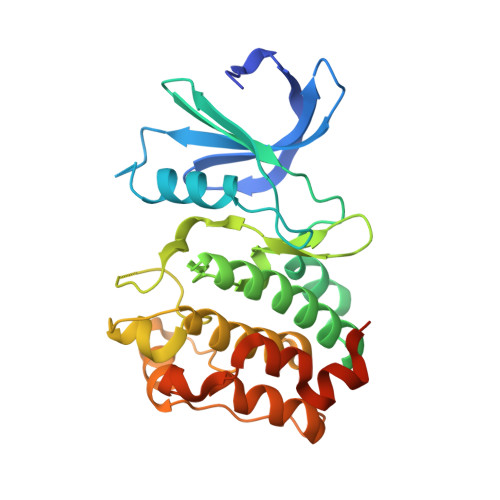Imidazo[4,5-b]pyridine derivatives as inhibitors of Aurora kinases: lead optimization studies toward the identification of an orally bioavailable preclinical development candidate.
Bavetsias, V., Large, J.M., Sun, C., Bouloc, N., Kosmopoulou, M., Matteucci, M., Wilsher, N.E., Martins, V., Reynisson, J., Atrash, B., Faisal, A., Urban, F., Valenti, M., de Haven Brandon, A., Box, G., Raynaud, F.I., Workman, P., Eccles, S.A., Bayliss, R., Blagg, J., Linardopoulos, S., McDonald, E.(2010) J Med Chem 53: 5213-5228
- PubMed: 20565112
- DOI: https://doi.org/10.1021/jm100262j
- Primary Citation of Related Structures:
2X6D, 2X6E - PubMed Abstract:
Lead optimization studies using 7 as the starting point led to a new class of imidazo[4,5-b]pyridine-based inhibitors of Aurora kinases that possessed the 1-benzylpiperazinyl motif at the 7-position, and displayed favorable in vitro properties. Cocrystallization of Aurora-A with 40c (CCT137444) provided a clear understanding into the interactions of this novel class of inhibitors with the Aurora kinases. Subsequent physicochemical property refinement by the incorporation of solubilizing groups led to the identification of 3-((4-(6-bromo-2-(4-(4-methylpiperazin-1-yl)phenyl)-3H-imidazo[4,5-b]pyridin-7-yl)piperazin-1-yl)methyl)-5-methylisoxazole (51, CCT137690) which is a potent inhibitor of Aurora kinases (Aurora-A IC(50) = 0.015 +/- 0.003 muM, Aurora-B IC(50) = 0.025 muM, Aurora-C IC(50) = 0.019 muM). Compound 51 is highly orally bioavailable, and in in vivo efficacy studies it inhibited the growth of SW620 colon carcinoma xenografts following oral administration with no observed toxicities as defined by body weight loss.
Organizational Affiliation:
Cancer Research UK Centre for Cancer Therapeutics, The Institute of Cancer Research, 15 Cotswold Road, Sutton, Surrey, SM2 5NG, United Kingdom. vassilios.bavetsias@icr.ac.uk
















